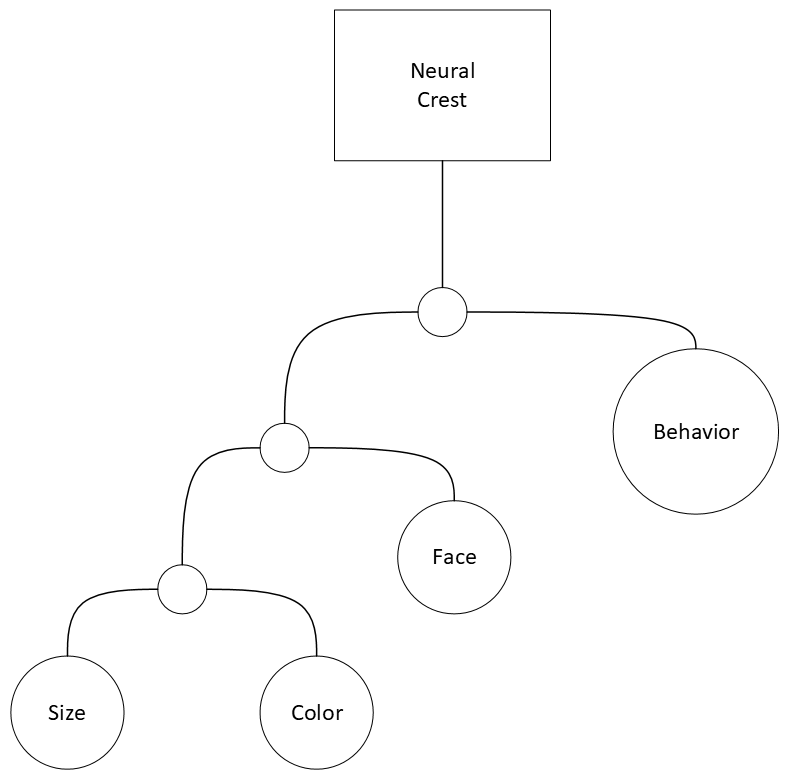The neural crest, an embryonic structure that contributes to the development of various traits, plays a significant role in the interconnectedness of size, color, behavior, and facial features. Imagine a mobile with four strings dangling from acentric arms balancing connections to size, color, face and behavior. If you pull (select for) one, the others will move (change). This kinetic mobile analogy demonstrates how the selection of one trait can impact multiple others, leading to a cascade of changes across generations. This was made obvious when Dmitry Belyaev performed his now famous wild fox study (Belyaev, 1979). After 20 years of intense selection for a more manageable animal, morphological characteristics emerged that are not found in wild animals, but which are prevalent in domestic dogs. In Belyaev’s fox study, the domestication process and the resulting interconnected changes in the foxes’ morphology and behavior serve as a fascinating insight into the genetic basis of domestication and the complex interactions between traits.
The neural crest’s role in the development of various traits has significant implications for applied dog breeding. By understanding how the neural crest contributes to the interconnectedness of traits such as size, color, behavior, and facial features, English Shepherd breeders can make more informed decisions when selecting for specific characteristics.
Cascading consequences: When English Shepherd breeders select for a specific trait, they should be aware that other traits linked through the neural crest may also change. For example, selecting for a particular coat color might impact the size or behavior of the dogs being bred, and vice-versa. Breeders should consider the possible ramifications of their selections.
Health concerns: Some traits linked to the neural crest may have health implications for dogs. For example, selecting for specific facial features (e.g., brachycephaly) has led to breathing difficulties, dental issues, or other health problems in other breeds. Another example might be how pushing the limits of body length and body height to gain advantage in performance sports can lead to structural problems. English Shepherds breeders should be aware of potential health risks associated with certain traits and strive to prioritize the well-being of the dogs they breed.
Genetic diversity: Understanding the interconnectedness of traits influenced by the neural crest can help breeders maintain genetic diversity within dog breeds. By selecting for a broader range of traits or avoiding extreme trait combinations, breeders can promote overall breed health and reduce the risk of hereditary health issues.
Preservation of bloodline characteristics: English Shepherd breeders can use their knowledge of neural crest-related traits to maintain and enhance bloodline-specific characteristics, ensuring that these features remain consistent across generations. On balance, we should also be cautious about inadvertently selecting for extreme traits that could be detrimental to the bloodline’s health and well-being.
Temperament and behavior: As neural crest cells play a role in the development of the nervous system, English Shepherd breeders should consider how selecting for specific behavioral traits might impact other aspects of a dog’s temperament or even its physical features. For instance, selecting for a calm and friendly demeanor may lead to changes in coat color or facial features over generations, as seen in Belyaev’s fox study.
By understanding the role of the neural crest in dog development and trait interconnectedness, English Shepherd breeders can make more informed decisions when selecting for specific characteristics, ultimately leading to healthier and more well-adapted dogs.
Further Reading
To further explore the topics of neural crest, trait interconnectedness, and domestication, I recommend the following resources:
- Belyaev, D. K. (1979). Destabilizing selection as a factor in domestication. Journal of Heredity, 70(5), 301-308.
This is the original study by Dmitry Belyaev on the domestication of silver foxes, which showcases the complex interactions between traits. - Wilkins, A. S., Wrangham, R. W., & Fitch, W. T. (2014). The “domestication syndrome” in mammals: A unified explanation based on neural crest cell behavior and genetics. Genetics, 197(3), 795-808.
This paper discusses the “domestication syndrome” and provides a comprehensive explanation based on neural crest cell behavior and genetics. - Hall, B. K., & Hallgrímsson, B. (2011). Neural crest and the origin of vertebrates: A new head. In Neural Crest Cells: Evolution, Development, and Disease (pp. 1-16). Academic Press.
This book chapter provides an overview of neural crest cells, their role in vertebrate evolution, and their significance in development and disease. - Sánchez-Villagra, M. R., Geiger, M., & Schneider, R. A. (2016). The taming of the neural crest: A developmental perspective on the origins of morphological covariation in domesticated mammals. Royal Society Open Science, 3(6), 160107.
This article explores the origins of morphological covariation in domesticated mammals, with a focus on the role of the neural crest in development. - Serpell, J. A. (Ed.). (2016). The Domestic Dog: Its Evolution, Behavior, and Interactions with People. Cambridge University Press.
This book covers various aspects of dog evolution, behavior, and their relationship with humans, providing a comprehensive understanding of the topic and offering insights for applied dog breeding.

